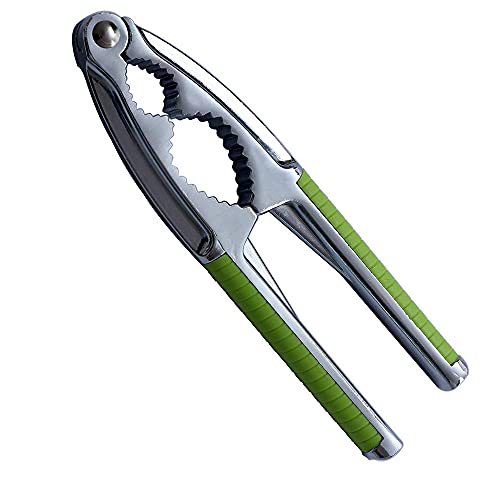
Anwenk Heavy Duty Nutcracker Tool
| Pros | Cons |
|---|---|
|
|
Our content is meticulously curated through independent research, testing, reviews, and AI-driven recommendations, all designed to present you with the finest product choices. When you make a purchase through our links, it could result in us earning a commission.

Instead of cracking nuts open with a hammer, use a nut cracker tool instead to save you time, energy, and frustration. Specifically designed to crack open hard nutshell, the tool squeezes the nutshell by pressing down on the handles. The tool contains the shell fragments and preserves the inner core, letting you enjoy delicious nuts. If you're ready to make your life easier with a nut cracker tool, we’ve gathered the best nut cracker tools of 2024, with the Anwenk Heavy Duty Nutcracker Tool leading the list as our top pick. What’s more, we’ve answered all of your nut cracker questions so you can be sure to choose the perfect tool for you!
With so many different types of nutcracker tools on the market, it’s easy to feel overwhelmed or confused when choosing the right one for you. We’ve put together this detailed buyer’s guide to help you with your selection while also providing some helpful tips and suggestions. The last thing we want is for you to end up with a product that damages the nut’s softcore leaving you with no nut to enjoy! Below, we’ll go over some important factors to consider — like material, design, and even how to properly use a nutcracker tool. So, read on if you’re curious to learn more about what factors to pay attention to while shopping for a top nutcracker tool!
Based on how it’s operated, nutcrackers can be divided into two categories: Spring-loaded and hinged. Spring-loaded crackers are best suited for opening soft to medium-hard-shelled nuts, while hinged tools can easily open most nuts, regardless of the shell’s hardness.
Most nutcracker tools have a V-shaped handle design with smooth edges. Because it might be difficult to crack open hard-shelled nuts, make sure to choose a product reinforced with an ergonomic handle. This will reduce stress on your hands and prevent fatigue. Plus, you won’t have to deal with sharp pain in your palm and fingers while cracking.
The grip is essential for having proper control over the nutcracker handle and for keeping the nuts in the right position, preventing them from slipping while you’re trying to open the shell. We recommend choosing a tool with an anti-slip handle, which will give you full control. Also, look for a nutcracker tool with a groove design on the inner walls; these grooves will securely grip the nutshell and keep the nut in place all while improving your overall handling of the tool.
Some nut-cracking tools have a cup-shaped head where you place the nut. These deep bowl-like holders make it easier to break open the shells. Plus, the broken shell pieces will remain inside the cup-shaped head, rather than flying off in different directions. On the other hand, some crackers feature a plier design with sawtooth or machined teeth on the inner walls where you place the nut. This unique design helps you establish a better grip over the nut and prevents the nut from slipping.
In some nutcracker sets, you’ll receive two different-sized crackers — a big one and a small one. These versatile products allow you to crack a large nut (such as a walnut or macadamia nut) and a small nut (like pecans and almonds). However, most nutcracker tools feature only a single cracking bowl or sawtooth section with a fixed size. Keep in mind that these products won’t be able to crack nuts of different shapes and sizes.
Some nutcracker tools come with two or four picks. These are slim, long tools with a tapered or pointed tip that help you release the nut’s softcore from the shell.
Nutcrackers are made from a variety of materials, each having its own pros and cons that affect the tool's overall performance. Below, we go through these materials and tell you what you need to know when making your decision.
Most nutcrackers have an enameled die-cast aluminum body. This material is not only hard and tough but has the ability to withstand wear and tear. Plus, aluminum is a lightweight material, allowing you to use the tool easily without tiring out your hand.
Nutcracker tools shaped in the form of an inverted V and having a hinged fulcrum are usually made from zinc or brass. These types of crackers are extremely lightweight and are strong enough to withstand pressure when cracking hard-shelled nuts. They are also resistant to rust and other types of corrosion.
Some nutcrackers have a wooden handle, which is great for cracking nuts in the winter because it won’t become cold (like metal handles). Other nutcracker tools are made with handles that have a plastic cover over an aluminum frame. This combination of materials offers you a better grip on the tool and helps you effortlessly crack open any nut.
A few nutcracker products are designed with teeth made out of stainless steel. Stainless steel is one of the hardest materials and allows the cracker to break hard shells without forcing you to apply extra pressure on the handles. What’s more, this material makes the tool wear-resistant, durable, and sturdy.
To use a nutcracker tool, follow these simple steps:
A nutcracker tool usually costs between $6 and $12, based on a number of different factors. For instance, a plier-shaped tool will cost less than a spring-loaded nutcracker. Similarly, zinc nutcrackers tend to be pricier than aluminum options.

| Pros | Cons |
|---|---|
|
|

| Pros | Cons |
|---|---|
|
|

| Pros | Cons |
|---|---|
|
|

| Pros | Cons |
|---|---|
|
|

| Pros | Cons |
|---|---|
|
|